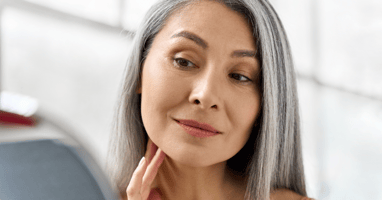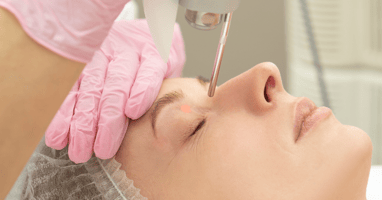In an era where beauty and self-confidence often go hand in hand, people are constantly seeking...
Everything you need to know about Botox
Do you know what exactly Botox is, and how does it work? Is it a fountain of youth or just another fleeting trend?
Whether you're a seasoned beauty enthusiast or someone simply curious about the possibilities Botox offers, this post will provide you with a deep understanding of what Botox is, how it works, and what you can expect from this remarkable procedure.
Join us as we demystify the secrets behind the procedure and reveal the main benefits that make Botox a transformative force in the world of cosmetic enhancement and therapeutic care.
What you can expect to find in this post:
Informative content ahead!
What is Botox and how is the procedure performed?
Botox is a neurotoxin produced by the bacterium Clostridium botulinum. It works by temporarily blocking nerve signals in the muscles where it is injected.
While this might sound concerning, when used in small, controlled amounts for cosmetic purposes, it can safely reduce the appearance of wrinkles and fine lines.
It is also a minimally invasive procedure that can provide a more youthful look without the need for surgery.
Here's a step-by-step breakdown of the process of administering Botox:
Consultation and pre-procedure care
During this initial meeting, you can discuss your goals and expectations with the practitioner, who will assess whether Botox is the right solution for you. They will also explain the procedure, its potential risks, and the expected outcomes.
During this first consultation, the practitioner may also discuss some pre-procedure care, such as:
- Avoid Blood Thinners: In the days leading up to your Botox appointment, it's best to avoid blood-thinning medications or supplements, such as aspirin, ibuprofen, and fish oil.
- Alcohol and Smoking: Limit alcohol consumption in the days before the procedure, as alcohol can contribute to bruising. If you're a smoker, consider quitting or at least refrain from smoking for a few days before and after the treatment, as smoking can slow down the healing process.
- Stay Hydrated: Proper hydration can help improve the results of the procedure and promote healthy, youthful skin. Drink plenty of water in the days leading up to your appointment.
- Topical Cream (if recommended): If your healthcare provider suggests it, you might apply a numbing cream to the treatment area before the procedure. Follow their specific instructions for the timing and application.
On the day of the treatment, you'll be seated comfortably in a clinic chair or treatment room. The practitioner will cleanse the area to be treated before the application of the botox injection.
They might apply a topical anesthetic or use ice to numb the area, but this is often unnecessary, as the injections are relatively painless.
Injections
The provider will then use a fine needle to inject Botox into the targeted muscles. Botox works by blocking the signals that cause the muscles to contract, thereby reducing the appearance of wrinkles and preventing the formation of new ones. The entire process usually takes no more than 15-20 minutes.
Recovery
There is little to no downtime associated with Botox injections. You can typically resume your daily activities immediately after the procedure. Some redness or swelling at the injection sites may occur, but this usually subsides within a few hours to a day.
However, it’s important to be attentive to some post-procedure care instructions, such as:
Avoid Touching the Treated Area: After the Botox injections, avoid touching or massaging the treated area for at least 24 hours. This helps prevent the toxin from spreading to unintended areas.
- No Intense Exercise: For the first 24 hours, it's best to avoid strenuous exercise and activities that could increase blood flow to the treated area, as this might cause the Botox to disperse.
- Maintain Skin Health: Continue to follow a healthy skincare routine, including cleansing, moisturizing, and using sunscreen to maintain the overall health and appearance of your skin.
- Stay in Touch: Remember to schedule follow-up appointments or contact your practitioner if necessary.
Also worth noting, Botox is considered a safe and effective treatment when administered by a qualified healthcare professional. However, like any medical procedure, there can be potential side effects and complications.
Some possible side effects and complications of Botox include:
- Temporary Bruising: Bruising at the injection site is one of the most common side effects of Botox. This usually resolves within a few days but can be concealed with makeup if desired.
- Pain or Discomfort: Some individuals may experience mild pain, discomfort, or tenderness at the injection sites. This usually subsides quickly.
- Swelling: Swelling at the injection sites is possible and typically goes away within a day or two.
- Headache: Although Botox is used to treat chronic migraines, it can occasionally cause mild headaches as a side effect.
- Flu-Like Symptoms: In rare cases, individuals may experience flu-like symptoms, including fatigue, muscle weakness, or fever.
Remember that Botox is a medical procedure, and the guidance of a qualified healthcare professional is essential for a safe and successful experience.
Are there different kinds of Botox?
Yes, there are different kinds of botox used for specific needs, usually serving a dual purpose in the world of therapeutic medicine and cosmetic enhancement.
It is used for both therapeutic and aesthetic treatments, offering a range of benefits beyond simply reducing wrinkles.

Aesthetic Botox Treatment
- Wrinkle Reduction: Botox is most commonly associated with its aesthetic use. It is used to reduce the appearance of wrinkles and fine lines on the face, particularly in areas such as the forehead, crow's feet, and between the eyebrows. Botox works by temporarily relaxing the muscles responsible for these wrinkles.
- Preventative Anti-Aging: Some individuals use Botox as a preventative measure to slow the development of wrinkles. By starting treatments in their late 20s or early 30s, they can delay the formation of dynamic wrinkles (wrinkles caused by facial expressions).
- Brow Lift: Botox can be used to lift and shape the eyebrows, creating a more youthful and alert appearance without surgery.
- Gummy Smile Correction: Injections can lower the upper lip slightly, reducing the appearance of a "gummy smile" caused by excessive gum exposure when smiling.
- Jaw Slimming: Botox can be injected into the masseter muscles in the jaw to achieve a slimmer, more contoured jawline.
- Neck Bands and Décolletage: Botox can be used to soften the appearance of neck bands and fine lines on the chest area, also known as the décolletage.
Therapeutic Botox Treatment
- Chronic Migraine: Botox is FDA-approved for the treatment of chronic migraines. It involves multiple injections around the head and neck to help reduce the frequency and intensity of migraine headaches.
- Muscle Spasms and Dystonia: Botox is employed to treat muscle spasms and dystonia, which are neurological conditions characterized by involuntary muscle contractions. It helps relax overactive muscles and alleviate symptoms.
- Hyperhidrosis (Excessive Sweating): Botox injections in the underarms, palms, or soles of the feet can effectively reduce excessive sweating by blocking the signals that trigger sweat production.
- Strabismus and Blepharospasm: Botox can be used to treat eye conditions like strabismus (crossed eyes) and blepharospasm (uncontrollable blinking or eye twitching) by relaxing the muscles responsible for these issues.
The dosages, injection sites, and techniques vary depending on the intended purpose, and a proper evaluation by a healthcare provider is crucial to ensure safe and effective results.
Whether for medical or cosmetic reasons, Botox has become a versatile tool in the fields of healthcare and beauty, offering patients a wide range of benefits.
Results and benefits of Botox
After receiving a Botox treatment, you may start to notice the effects within a few days. The muscles responsible for wrinkles in the treated area gradually become more relaxed, resulting in smoother skin.
In its peak effectiveness at around two weeks after the injection you'll see the most significant reduction in wrinkles and lines.
Many people wonder about the benefits or how long does botox last. On average, the effects of Botox typically last between three to four months.
However, the duration of the effects of Botox treatments can vary from person to person and depends on several factors, including the specific area treated and the individual's metabolism.
To maintain the desired results, individuals often opt for periodic retouching or follow-up Botox treatments. These can be scheduled every three to four months, or as recommended by your healthcare provider. By maintaining a regular treatment schedule, you can enjoy consistent results.
As Botox begins to wear off, muscle activity gradually returns. Wrinkles and lines may reappear, but they are often less severe than before treatment. Regular retouching can help prevent these lines from becoming deeply ingrained.
Additionally, always follow your provider's post-treatment care instructions to optimize the longevity of your Botox effects.
Summary: Botox is a minimally invasive procedure that may be used for both cosmetic and therapeutic purposes. The benefits of Botox extend beyond cosmetic enhancements, addressing various medical conditions and enhancing the overall quality of life for many individuals.
Would you like to know more about other non-surgical and minimally invasive cosmetic procedures that may bring out your inner beauty? Find out more in our post about Body Contouring.


